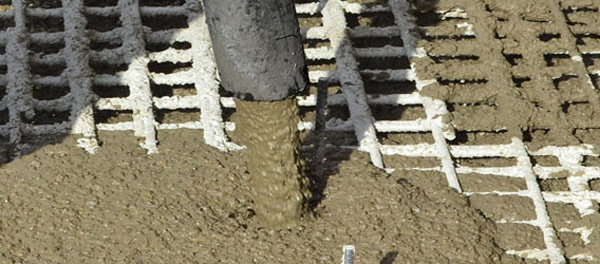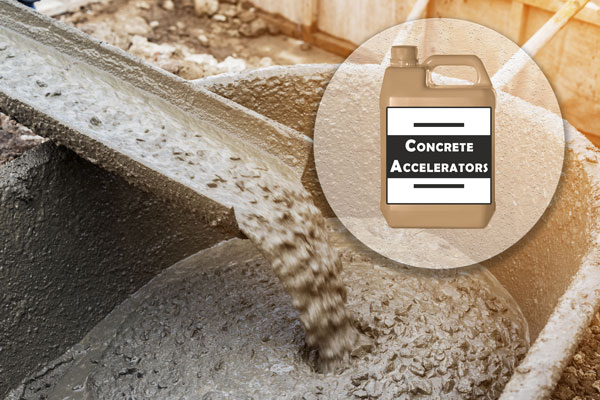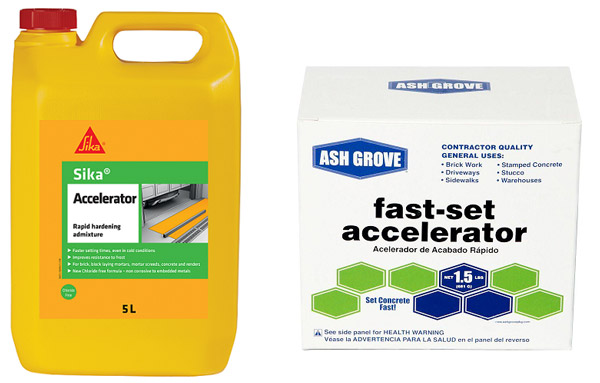Concrete is the most essential material in the construction. This is made from cement, sand, aggregates, water, and concrete admixtures. Concrete admixtures or concrete additives are the important materials which are used to modify the properties of fresh concrete as well as the hardened concrete such as an increase or decrease in setting time, increase hardening, workability, strength, unit weight etc. Concrete admixtures are added before mixing or during mixing of concrete. There are different types of concrete admixtures/concrete additives or construction chemicals available in the market. Some of them are concrete accelerators, plasticizers, Superplasticizer, retarder, air entraining admixtures etc.

Accelerating Admixture:
An admixture that causes an increase in the rate of hydration of the cement and thus shortens the time of setting, increases the rate of strength development, or both.
All the concrete admixtures give different effects and modification to properties of concrete. Different natural or manufactured chemicals are used as admixtures. Now we are going to discuss the concrete accelerators, their classifications, advantages, disadvantages, application etc.
What are Concrete Accelerators?
According to ‘A. M. Neville’, honorary member of the American Concrete Institute, Concrete accelerators are the substance that accelerates the early strength development of concrete, i.e. hardening and it may also accelerate the setting of concrete.
In more simple words, accelerating admixtures are added in the concrete for minimizing the setting time and increasing the rate of early strength development in concrete. It increases the rate of stiffening and the rate of hardening.
There is a difference in the stiffening and hardening. Stiffening means the concrete starts to get set and hardening means concrete starts to gain strength after setting. Chemical compositions of accelerators include some of the inorganic compounds such as soluble chlorides, carbonates, silicates, fluosilicates, and some organic compounds such as triethanolamine.
Concrete Accelerators: How it Works?

Concrete accelerators are used for minimizing setting time, the main action of the accelerator occurs in the plastic state of the cement paste. When it’s used for hardening of concrete, the accelerator acts primarily in the hardened state. Some concrete accelerators affects either in setting or hardening, while several accelerators affects both in setting and hardening.
As it is seen, when water is mixed with the cement, chemical reactions (hydration) takes place, which is responsible for the setting and hardening of concrete. The rates of this chemical reaction (rate of hydration) can be changed by adding small amounts of chemical substances to the cement-water mix. Such chemical substances affect these rates to give an overall increase the hydration rate, i.e. an accelerating effect and therefore, they are termed as concrete accelerators or accelerating admixtures.
Accelerating admixtures can be used in powder form, slurry form or liquid form, during mixing of concrete or before mixing of concrete.
Classification of Concrete Accelerators
Concrete accelerators can be classified according to their difference between setting and hardening properties, type of concrete in which they are used and on their physical forms, in which they are used. As per the ‘Myrdal, Roar. (2007)’ R&D director construction chemical, Norway & senior scientist at SINTEF building and infrastructure, classification of concrete accelerators are as follows:01. As per the difference between setting and hardening properties:
- Set Accelerating Admixture –
This decreases the time to commencement of transition of the mix from the plastic, to the rigid state.
- Hardening Accelerating Admixture –
This increases the rate of development of early strength in the concrete, with or without affecting the setting time.02. As per the type of concrete:
- Accelerators for Normal Concrete –
In this, accelerators are added during mixing at a concrete plant.
- Shotcrete Accelerator for Sprayed Concrete –
In this, accelerators added in the nozzle of the equipment during concrete spraying.03. As per their physical form:
- Powder Form –
In these accelerators are Insoluble inorganic salts and compounds.
- Liquid Form –
In these accelerators are water-soluble inorganic and organic salts and compounds.
- Slurry Form –
In these accelerators are insoluble, inorganic salts and compounds dispersed in water.
Application of Concrete Accelerators
- Accelerators are used in the construction when the structure is to be placed shortly in the service.
- Accelerating admixtures are used in the emergency repair work in road pavements, repairs of existing buildings etc.
- Concrete accelerators are used for the underwater concreting and for the repair work of the waterfront structures in the tidal variation’s region.Know the different types of concreting methods that helps to place the concrete in underwater.
- These are also used for the basement waterproofing operations.
- Concrete accelerators are used in cold weather concreting because, it partially compensates the retarding effect of low temperature during cold weather concreting.
Advantages of Concrete Accelerators
- Some of the concrete accelerators produced now a days are so powerful that, it is possible to make the cement set into a stone hard in less than five minutes.
- Concrete accelerators permits earlier removal of formwork because, it increases the rate of early strength development in concrete;
- They provides earlier finishing of surfaces.
- Accelerating admixtures are also more beneficial in the field of pre-fabrication.
- Accelerating admixtures reduces the required period of concrete curing.
- Accelerating admixtures reduce the early heat of hydration and overcome thermal cracking problem in concrete.
- Concrete admixtures can accelerate the setting time as well as there are admixtures that decelerate concrete setting time.
Disadvantages of Concrete Accelerators
- As per the, ‘A. M. Neville’, honorary member of the American Concrete Institute, calcium chloride is the most commonly used accelerating admixture because it’s cheap, sufficient, and readily available in the market. But calcium chloride is harmful to reinforced concrete and prestressed concrete, as excessive amounts of calcium chloride may cause shrinkage and rapid stiffening while drying, creating cracks in the cured surface, promote corrosion in steel reinforcements and increase the potential for scaling.
- Hence most of the concrete specifications are restricting the use of calcium chloride or admixtures containing calcium.
Concrete Accelerators
- Most commonly used accelerating admixture was calcium chloride, but now a days it is not much used. Instead of calcium chloride, some of the silicates i.e. fluosilicates, soluble carbonates and organic compounds such as Triethenolamine are used. From all of them, fluosilicates and Triethenolamine are comparatively expensive.

(a) The popular manufacturers of concrete accelerators are as follows:
- Sika
- Fosroc
- ECMAS
- Perma
- Bauchemic etc
(b) Some of the modern commercial accelerating materials are as follows:
- Mc-Schnell OC
- Mc-Schnell SDS
- Mc-Torkrethilfe BE
Thus, manufactured by Mc-Bauchemic (Ind) Pvt. Ltd., MC-Torkrethilfe BE is a material specially formulated for sprayed concrete and shotcreting operations.
Lastly, the knowledge about the concrete accelerators or accelerating admixture is more helpful for its proper usage because accelerators are beneficial to concrete of course when it’s used properly.



